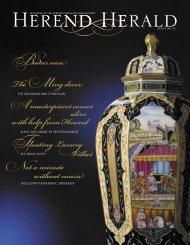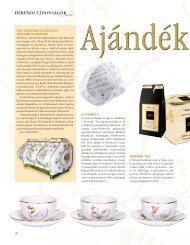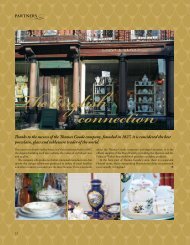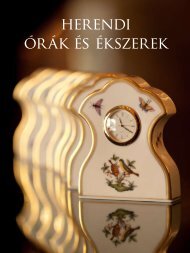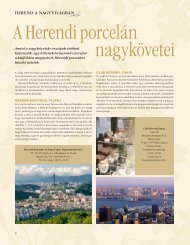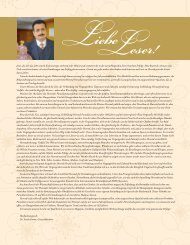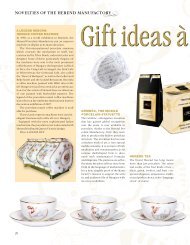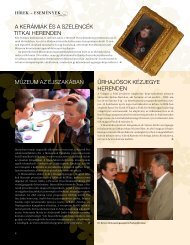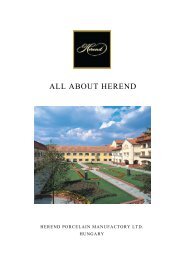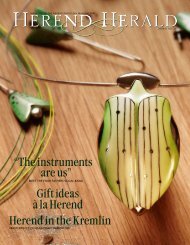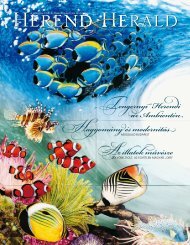LA PORCELAINE DE HEREND HEREND PORCELAIN
Genfi_32 q:Layout 1
Genfi_32 q:Layout 1
Create successful ePaper yourself
Turn your PDF publications into a flip-book with our unique Google optimized e-Paper software.
24 The original version of the small ornamental vase with<br />
a lid glittering as a jewel was made in 1856, and<br />
today it is kept in the Museum of Applied Arts. The<br />
gilded handle of the richly coloured lid of the vase s<br />
shaped like a Lion of Fo. Underneath it, fighting<br />
green- and red-scaled dragons appear amongst<br />
turquoise and green clouds; the back and the front<br />
panels have two larger paintings each representing<br />
the life of Chinese aristocracyThe original version of<br />
the small ornamental vase with a lid glittering as a<br />
jewel was made in 1856, and today it is kept in the<br />
Museum of Applied Arts. The gilded handle of the<br />
richly coloured lid of the vase s shaped like a Lion of<br />
Fo. Underneath it, fighting green- and red-scaled<br />
dragons appear amongst turquoise and green clouds;<br />
the back and the front panels have two larger paintings<br />
each representing the life of Chinese aristocracyvThe<br />
original version of the small ornamental vase<br />
with a lid glittering as a jewel was made in 1856, and<br />
today it is kept in the Museum of Applied Arts. The<br />
gilded handle of the richly coloured lid of the vase s<br />
shaped like a Lion of Fo. Underneath it, fighting<br />
green- and red-scaled dragons appear amongst<br />
turquoise and green clouds; the back and the front<br />
panels have two larger paintings each representing<br />
the life of Chinese aristocracyThe original version of<br />
the small ornamental vase with a lid glittering as a<br />
jewel was made in 1856, and today it is kept in the<br />
Museum of Applied Arts. The gilded handle of the<br />
richly coloured lid of the vase s shaped like a Lion of<br />
Fo. Underneath it, fighting green- and red-scaled<br />
dragons appear amongst turquoise and green clouds;<br />
the back and the front panels have two larger paintings<br />
each representing the life of Chinese aristocracyThe<br />
original version of the small ornamental vase<br />
with a lid glittering as a jewel was made in 1856, and<br />
today it is kept in the Museum of Applied Arts. The<br />
gilded handle of the richly coloured lid of the vase s<br />
shaped like a Lion of Fo. Underneath it, fighting<br />
green- and red-scaled dragons appear amongst<br />
turquoise and green clouds; the back and the front<br />
panels have two larger paintings each representing<br />
the life of Chinese aristocracy haped like a Lion of Fo.<br />
Underneath it, fighting green- and red-scaled dragons<br />
appear amongst turquoise and green clouds; the back<br />
and the front panels have two larger paintings each<br />
representing the life of Chinese aristocracy<br />
traditions did not accommodate this kind of work. Despite<br />
important studio work, Herend continued to earn<br />
its revenue from the sale of traditional Herend patterns.<br />
The demand for porcelain and the growth in production<br />
can be traced through the increasing number of emplo -<br />
yees. In 1948 there were approximately 300 workers,<br />
in 1965 more than 600, in 1970 nearly 1,000, and in<br />
1973, 1,203. In 1981 Herend split from the Fine Cera -<br />
mics Works, but it only gained the right to commercial<br />
autonomy in 1985, with the company council taking over<br />
the main management. From then on, design, decisionmaking<br />
and operational work were all carried out in the<br />
same place as production, thus all facets working in<br />
greater harmony. A market perspective opened many<br />
doors, and the state’s economic and political monopoly<br />
over the porcelain factory had clearly begun to waver.<br />
That year, the Herend Studio was formed with the participation<br />
of three designers, László Horváth, Zoltán<br />
Takács and Ákos Tamás, their energy and talent representing<br />
a new level in the artistic range of the porcelain<br />
factory.<br />
The new phenomenon of the 1970s, the world dominance<br />
of information science, linked products and markets<br />
throughout the world. The structure of the state and<br />
of labour practices within the Soviet sphere, however,<br />
was built on isolationism, in contradiction to the free flow<br />
of information and market mobility. Another phenomenon<br />
of the decade was the oil crisis, with the dramatic<br />
rise in fuel prices forcing irreversible changes within the<br />
Soviet realm. By the end of the 1980s the resources of<br />
the planned economy were exhausted, and Hungary had<br />
accumulated a huge national debt. The state ownership<br />
monopoly also dissolved, and alongside cooperative<br />
ownership, economic work groups appeared, which primarily<br />
produced articles of mass consumption; these<br />
small enterprises were the pioneers of a freely emerging<br />
market economy in the 1990s. The formation of new<br />
political parties or the reformation of old ones, all urging<br />
social change, was the first big step toward the end of<br />
communism and the beginning of parliamentarianism<br />
and multi-party democracy.<br />
Herend in the new millennium (1991-2008)<br />
The change in political systems began in Herend in the<br />
autumn of 1989. The factory’s reputation and strong<br />
financial situation made it attractive to privatization, with<br />
various groups of domestic and foreign investors showing<br />
interest. The managing body of the factory, the company<br />
council, declared an employee buyout the best route<br />
to privatization. That year the company council chose<br />
József Kovács, head of the commercial department of<br />
the factory, from several candidates to become managing<br />
director. The company now had at its head a man not<br />
only well regarded by the state leadership but also res -<br />
pected for his international experience and connections,<br />
his knowledge and professionalism, his skill in foreign<br />
languages, and above all his determination and consistency.<br />
After thorough preparations, the process of priva-<br />
The original version of the small ornamental vase with<br />
a lid glittering as a jewel was made in 1856, and<br />
today it is kept in the Museum of Applied Arts. The<br />
gilded handle of the richly coloured lid of the vase s<br />
shaped like a Lion of Fo. Underneath it, fighting<br />
green- and red-scaled dragons appear amongst<br />
turquoise and green clouds; the back and the front<br />
panels have two larger paintings each representing<br />
the life of Chinese aristocracyThe original version of<br />
the small ornamental vase with a lid glittering as a<br />
jewel was made in 1856, and today it is kept in the<br />
Museum of Applied Arts. The gilded handle of the<br />
richly coloured lid of the vase s shaped like a Lion of<br />
Fo. Underneath it, fighting green- and red-scaled<br />
dragons appear amongst turquoise and green clouds;<br />
the back and the front panels have two larger paintings<br />
each representing the life of Chinese aristocracyThe<br />
original version of the small ornamental vase<br />
with a lid glittering as a jewel was made in 1856, and<br />
today it is kept in the Museum of Applied Arts. The<br />
gilded handle of the richly coloured lid of the vase s<br />
shaped like a Lion of Fo. Underneath it, fighting<br />
green- and red-scaled dragons appear amongst<br />
turquoise and green clouds; the back and the front<br />
panels have two larger paintings each representing<br />
the life of Chinese aristocracyThe original version of<br />
the small ornamental vase with a lid glittering as a<br />
jewel was made in 1856, and today it is kept in the<br />
Museum of Applied Arts. The gilded handle of the<br />
richly coloured lid of the vase s shaped like a Lion of<br />
Fo. Underneath it, fighting green- and red-scaled<br />
dragons appear amongst turquoise and green clouds;<br />
the back and the front panels have two larger paintings<br />
each representing the life of Chinese aristocracyThe<br />
original version of the small ornamental vase<br />
with a lid glittering as a jewel was made in 1856, and<br />
today it is kept in the Museum of Applied Arts. The<br />
gilded handle of the richly coloured lid of the vase s<br />
shaped like a Lion of Fo. Underneath it, fighting<br />
green- and red-scaled dragons appear amongst<br />
turquoise and green clouds; the back and the front<br />
panels have two larger paintings each representing<br />
the life of Chinese aristocracy panels have two larger<br />
paintings each representing the life of Chinese aristocracyThe<br />
original version of the small ornamental<br />
vase with a lid glittering as a jewel was made in 1856,<br />
and today it is kept in the Museum of Applied Arts.<br />
The gilded handle of the richly coloured lid of the vase<br />
s shaped like a Lion of Fo. Underneath it, fighting<br />
tization began. In June 1992 the Herend Porcelain Share<br />
Company was formed as the legal successor to the He -<br />
rend Porcelain Factory. In the 1990s Herend experience<br />
development unprecedented in the Hungarian economy.<br />
After the employee buyout, Herend began making investments<br />
in the company using its own financial resour -<br />
ces, creating an environment befitting the sumptuous<br />
luxury porcelain it produced. The factory buildings were<br />
modernized, and the building erected by Mór Fischer<br />
was restored as a historical monument and a permanent<br />
exhibit installed with space for temporary shows. The<br />
group of buildings opposite the factory comprise the<br />
Porcelánium. Here visitors can discover the secrets of<br />
porcelain-making in the so-called Mini-manufactory, or<br />
have a meal served on real Herend dishware at the<br />
restaurant and café Apicius, named for the ancient<br />
Roman gourmet, or purchase Herend goods in Viktória,<br />
the factory’s porcelain shop.<br />
With initiatives embracing the traditions of manufactured<br />
porcelain, Herend found partners among the most important<br />
representatives of artistic porcelain in Europe. In<br />
April 1992 the Association of European Porcelain Manufacturers<br />
was formed with the participation of Vienna,<br />
Berlin, Herend, Ludwigsburg, Meissen and Sevres. The<br />
cooperating companies agreed to make their own pastes<br />
and whiteware, do all painting by hand, nurture the<br />
traditions of the applied arts, conduct training seminars<br />
and offer a selection of products that have art historical<br />
significance.<br />
In 1993, Imre Schrammel, a prominent figure in Hungarian<br />
and international ceramic art, participated in<br />
the work of the managing council. With his talent, his<br />
ready knowledge of international trends, his demanding<br />
personality, and his suggestive works of art, Schrammel<br />
had considerable influence on colleagues and students,<br />
serving as rector of the Hungarian Academy of Applied<br />
Arts [from 2001 the Hungarian University of Craft and<br />
Design, from 2006 the Moholy-Nagy University of Design].<br />
He taught generations of students in the cera mics<br />
department, launching them on their careers. He is<br />
primarily responsible for the change in philosophy at<br />
Herend, based on his view that production development<br />
had ceased for some time. The factory’s technological<br />
revival and perfection paved the way for Herend to invite<br />
not only designers from its own studio, but also Hunga -<br />
rian ceramicists and sculptors to a “figure-symposium” in<br />
Siklós in 1995. This melding of ideas led Herend to call<br />
upon sculptor Miklós Melocco, ceramicist Márta Nagy<br />
and porcelain designer Pálma Babos to come up with<br />
new designs. Schrammel himself took an earlier series of<br />
chamotte-clay Minotaurs and refashioned it for porcelain.<br />
Sometimes triumphant, historicizing, sometimes<br />
frail and writhing, suffering from love, embracing bullheaded<br />
monsters, the figures are revived symbols from<br />
the world of human instinct. Their bodies are covered in<br />
typical Herend motifs, the body and paint merged as one.<br />
Imre Schrammel’s most mature work for Herend is his<br />
carnival series, his female figures in renaissance costume<br />
peaking out from behind flirtatious masks. For Schram-<br />
25



